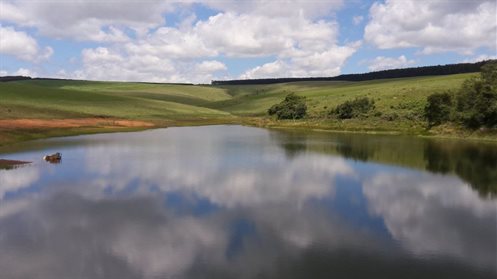On the United Nations' International Day of Biodiversity, celebrated on 22 May every year, the global community is called to re-examine its relationship to the natural world. In South Africa, where Sappi is one of the country's major landowners, the company is proud to lay claim to this year's theme which states: "We're part of the solution." Of the 394,000 hectares of its owned and leased land, Sappi manages approximately one-third for biodiversity, which includes seven proclaimed nature reserves as part of our conservation efforts.

Roelton Dam supplies water to Ixopo
One such project takes place on the Sappi Sutton plantation, near the town of Ixopo in KwaZulu-Natal, which features a patch of KZN Mistbelt Grassland, situated within the 118ha Roelton Nature Reserve. It is here on this land that has been identified as an Important Bird and Biodiversity Area (IBA) that the critically endangered Blue Swallow (Hirundo atrocaerulea) comes to breed every summer.
This elusive migrant bird is uniquely adapted for the misty conditions in the grasslands, and with less than 40 pairs left in South Africa, they enjoy the protection of BirdLife South Africa’s Blue Swallow Stewardship Project. This programme formally protects the last known breeding sites of the Blue Swallow in South Africa under the national Biodiversity Stewardship initiative, in conjunction with KZN conservation authority, Ezemvelo KZN Wildlife.
The Roelton Nature Reserve was the most recent formally protected area (FPA) within Sappi’s landholdings – which was added to its list of six other areas proclaimed under the National Environmental Management: Protected Areas Act (Act 57 of 2003). These FPAs are protected through partnerships between landowners, provincial conservation authorities and NGOs to secure biodiversity, giving long-term security to sites that are important for the conservation of biodiversity and ecosystem services. The small 118ha Roelton Nature Reserve is also home to the Mistbelt Chirping Frog, currently listed as ‘endangered’ by the IUCN (International Union for Conservation of Nature) Red List of Threatened Species.
The six other nature reserves that fall under Sappi’s protection are:
The Oosterbeek Nature Reserve and Angle Ridge Nature Reserve (2,997ha) are both located in the Highlands Management unit of Sappi’s Twello plantation. These reserves lie within the headwaters of the Mhlumati and Mtsoli Rivers within the InKomati Water Management Area, which is of strategic importance in supplying water to the region, including Mozambique. The value of these areas lies in the fact that they are areas of outstanding natural beauty and are part of the Barberton Centre of Endemism and Barberton Mountainlands, an ecosystem gazetted as vulnerable.
The Mount Morgan Nature Reserve, a grassland portion (1,013ha) of the Montrose and Kempstone management units of Sappi’s Twello plantation, is an area of outstanding natural beauty containing serpentine outcrops with associated endemic species (unique serpentine flora: e.g. Berkheya coddi, species of Inezia) adapted to high levels of heavy minerals.
The Ngodwana River Valley Nature Reserve is a grassland and woodland area (965ha) of the Sappi Nooitgedacht plantation in Mpumalanga. The area is representative of a transition between two Endangered vegetation types – Northern Escarpment Dolomite Grassland and Legogote Sour Bushveld – and lies adjacent to Coetzeestroom Nature Reserve. Accordingly, it’s important for protected area consolidation and expansion.
The 940ha Clairmont Mountain Nature Reserve on Sappi’s Clairmont plantation in KwaZulu-Natal comprises several habitats with high conservation value including 811ha of grasslands; 129.6ha of indigenous forests; and 3.6ha of wetland. Due to this diversity of habitats, Clairmont Mountain is also rich in biodiversity and home to a number of critically endangered, endangered, vulnerable and red data list species. It is also home to species of cultural importance, including a host of medicinal plants.
The Karkloof Nature Reserve in KwaZulu-Natal, of which Sappi owns 223ha, is a vital and significant area because of its biodiversity. The reserve comprises predominantly Mistbelt Forest and Mistbelt Grassland.Besides the seven nature reserves, Sappi also maintains 160 Important Conservation Areas (ICAs) on its landholdings.
Find out more at https://www.sappi.com/managing-for-biodiversity, #ForNature and check out the Forestry SA site at https://bit.ly/3u6jpRM
You can also view this short video here:
About Sappi Southern Africa
Sappi is a leading global provider of powerful everyday materials made from woodfibre-based renewable resources. As a diversified, innovative and trusted leader focused on sustainable processes and products, we seek to support a more circular economy.
Sappi is powered by the expertise of more than 12,000 people worldwide; with headquarters in four key regions: South Africa, Europe, North America and Asia.
Locally, we have a footprint in Gauteng (head office), KwaZulu-Natal (three mills and a shared services hub), Mpumalanga (two mills) and the Western Cape (sales office staff). Our product offering in SA include dissolving pulp, packaging and specialities, graphic papers and forestry products.
We also generate shared value in the communities in which we operate by investing in skills training and SMME development to boost employment and grow the economy.
Sappi will continue to build a thriving world by acting boldly to support the planet, people and prosperity.
Find out more at https://www.sappi.com/
About the Blue Swallow:
Blue swallows (Hirundo atrocaerulea) arrive for breeding in South Africa from Uganda and Kenya at the end of September. In grasslands, they build cup-shaped nests from mud and grass on the inside of sinkholes cavities and aardvark burrows. At Roelton, there are also man-made holes that have been made specifically to encourage breeding pairs. The blue swallow migrates seasonally within the African continent, breeding in South Africa, Swaziland, Zimbabwe, Malawi, Zambia, Tanzania, Mozambique and Democratic Republic of Congo. During April the birds journey back to Uganda and Kenya for winter.
BirdLife International in 2012 estimated blue swallows' total population to be around 1,000 breeding pairs. The South African population was only estimated to be less than 40 pairs in 2012. The blue swallows population is decreasing throughout its distribution range. Globally, the blue swallow is classified as vulnerable while nationally it is classified as critically endangered (IUCN Red List).
Find out more at https://bit.ly/2QFDykg









































